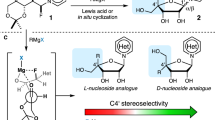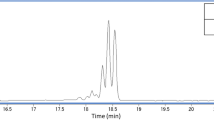Abstract
EXPERIMENTAL determinations of carbon-metal and carbon-halogen bond dissociation energies have been investigated in this Department during the past few years1–4. The first work undertaken was a calorimetric study of the formation and subsequent decomposition of a Grignard reagent.  From (1) and (2), the heat of formation of the RI compound can be obtained:
From (1) and (2), the heat of formation of the RI compound can be obtained:  From Qf(RI,g), and the corresponding R—H dissociation energy, the R—I bond dissociation energy can be found. Even if the absolute value of the heat of formation as given by (3) is doubtful (owing to uncertainty in the value assumed for Qf(MgIOH)), the gradations in Qf values for a series of RI compounds should be reliable.
From Qf(RI,g), and the corresponding R—H dissociation energy, the R—I bond dissociation energy can be found. Even if the absolute value of the heat of formation as given by (3) is doubtful (owing to uncertainty in the value assumed for Qf(MgIOH)), the gradations in Qf values for a series of RI compounds should be reliable.
This is a preview of subscription content, access via your institution
Access options
Subscribe to this journal
Receive 51 print issues and online access
$199.00 per year
only $3.90 per issue
Buy this article
- Purchase on SpringerLink
- Instant access to full article PDF
Prices may be subject to local taxes which are calculated during checkout
Similar content being viewed by others
References
Carson, Hartley and Skinner, Proc. Roy. Soc., A, 195, 500 (1949).
Carson, Hartley and Skinner, Trans. Farad. Soc., [45, 1159 (1949)].
Carson and Skinner, J. Chem. Soc., 201, 936 (1949).
Carson, Pritchard and Skinner, J. Chem. Soc., [656 (1950)].
Author information
Authors and Affiliations
Rights and permissions
About this article
Cite this article
CARSON, A., SKINNER, H. Heat of Formation of the Grignard Reagent, CH3Mgl: Ether. Nature 165, 484 (1950). https://doi.org/10.1038/165484a0
Issue date:
DOI: https://doi.org/10.1038/165484a0



